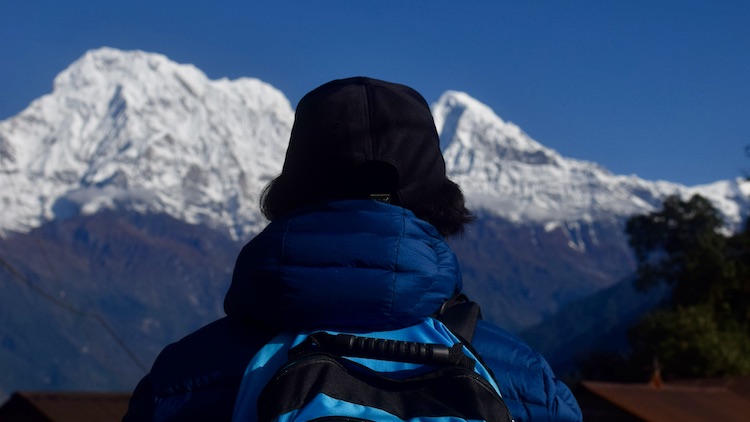Embarking on a thrilling adventure can be an exhilarating experience, but choosing the best trekking backpack to accompany you on your journey is crucial. Gone are the days of one-size-fits-all packs. Today, there is an overwhelming array of options available, each designed to cater to different needs and preferences. Whether you’re a novice trekker or an experienced hiker, finding the perfect hiking backpack that balances comfort, durability, and functionality can make or break your outdoor escapade.
In this comprehensive guide, we will look at the five best trekking backpacks while providing a full buyers guide for hiking backpacks. Through extensive use while trekking in Nepal, and traveling around the world we evaluate capacity and weight distribution, understanding the importance of adjustable straps and ventilation systems, and how to choose the right pack overall. If you are planning on going trekking in Nepal, don’t forget to check out our blog on best trekking insurance!
So, get ready to explore the world of trekking backpacks and discover the essential factors that will help you make an informed and confident choice. Let’s start by looking at our five recommended trekking backpacks.
Disclaimer: This review post contains affiliate links. They help me earn a little extra cash so I can keep backpacking and trekking!
The Best Trekking Backpack:
Editors Choice
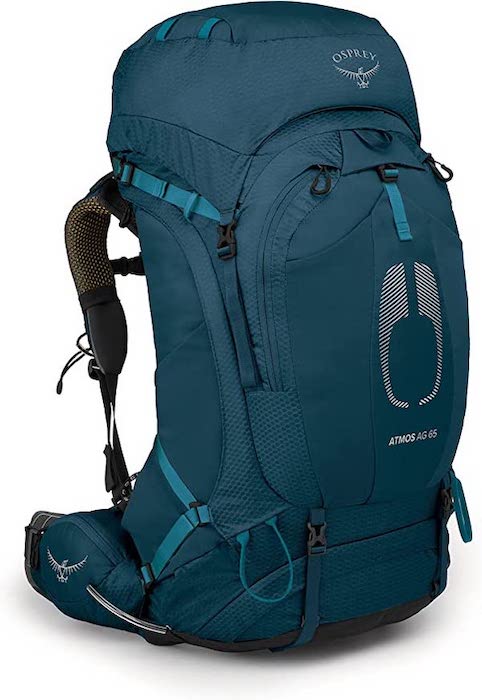
Osprey Atmos AG 65

Price: $303

A great all-round backpack for all your trekking needs

Perfect for trekkers needing durability, comfort, and size.
2nd Best Choice

Osprey Aether 65

Price: $320

Super lightweight but still retains it strength to carry heavy loads

Great for hikers needing a sturdy and durable pack for heavy loads
3rd Best Choice
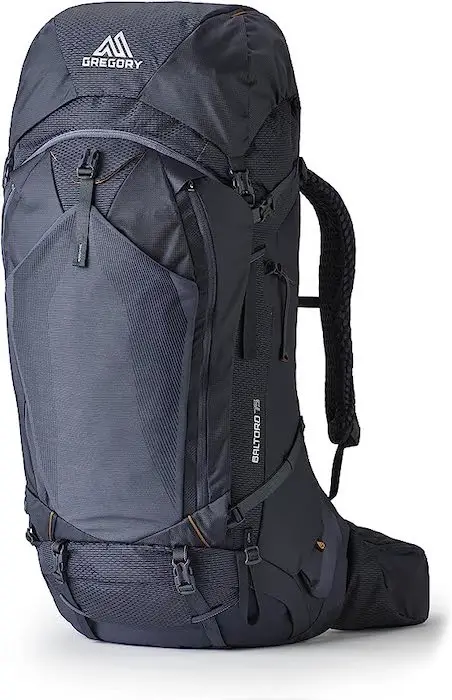
Gregory Baltoro 75

Price: $360

Perfect for heavy loads while trekking. Maintains comfort even when full.

Perfect for trekkers that need a sturdy and durable pack for heavy loads
Below is a full run down of the five best trekking backpacks! Including information about the price, weight, fabric and more. After the table we give our personal review for each of the bags and why we love using them when trekking!
| Trekking Pack | Price | Bag Weight | Fabric | Capacity | Bag Access | Number of Pockets |
|---|---|---|---|---|---|---|
| Osprey Atmos AG 65 | $340 | 4 lb. 9.8 oz. | Nylon (210D x 500D) | 50, 65L | Top | 8 exterior |
| Osprey Aether 65 | $320 | 4 lbs. 15 oz. | Nylon (210D & 420D) | 55, 65L | Top, front | 7 exterior |
| Gregory Baltoro 75 | $290 | 4 lb. 15.7 oz. | Nylon (210D & 420D) | 65, 75L | Top, front | 9 exterior |
| Osprey Exos 58 | $260 | 2 lb. 13.4 oz. | Nylon (100D & 400D) | 38, 48, 58L | Top | 6 exterior |
| Granite Gear Blaze 60 | $270 | 3 lbs | Robic nylon (100D & 210D) | 60L | Top, front | 6 exterior |
Breakdown and Overview of the Best Trekking Backpacks:
The sections below highlight our top five trekking backpacks. We recommend that you compare everything about the bags, as well as check out the buying tips below. Each bag has different pros and cons, and are suited for different types of travelers! We want to make sure you get the best trekking bag possible so you can bring everything on your trekking packing list!
That being said, let’s jump into our run down of the best trekking bags!
1. Osprey Atmos AG 65 ($340)

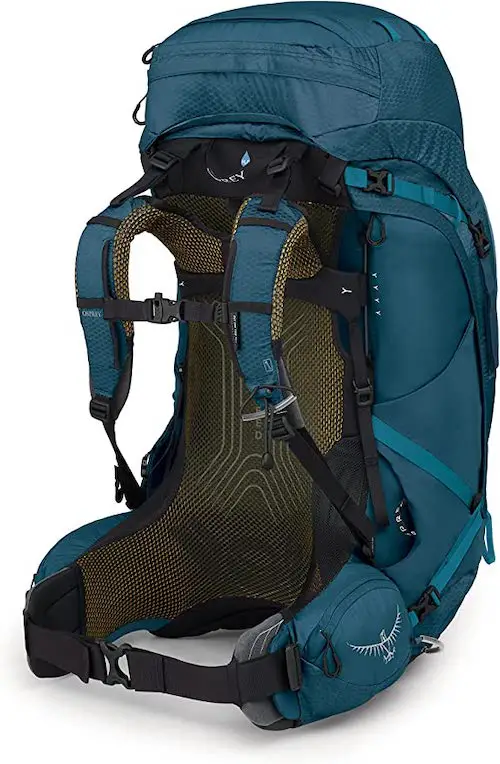
| Weight | Fabric | Capacities | What we like | What we don’t | Great for |
|---|---|---|---|---|---|
| 4 lbs. 9.8 oz. | Nylon (210D x 500D) | 50, 65L | A great all-rounder backpack with great ventilation. | On the more expensive side and fairly heavy (over 4.5 pounds) | The overall trekker and hiker that needs durability, comfort, and size. |
Our top trekking and hiking backpack is the Osprey Atmos AG. The comfort, organization, and durability is absolutely perfect, making it a well-rounded choice. The standout feature is the “Anti-Gravity” suspended mesh back panel, which replaces traditional foam designs to optimize ventilation and comfort. Additionally, we really like the pocket layout on the bag. It is designed well and offers ample options for organizing your trekking gear.
The Fit-on-the-Fly harness and hip belt allow for easy customization of the fit, and the high-quality materials ensure resilience even in rugged conditions. From quick overnight trips to extended backcountry adventures, the Atmos proves to be an exceptional backpack.
In the spring of 2022, Osprey introduced updates to the Atmos model. These include the addition of two side zips making it convenient to access the main compartment, torso length adjustment, and an integrated raincover. Furthermore, the pack’s fabrics have been modified to prioritize sustainability, with a shift towards a PFC-free durable water repellent finish, aligning with the industry trend. As a result, the Atmos AG 65 has undergone a price increase, surpassing the cost of the enhanced Aether model. Despite this, the Atmos AG 65 remains the best choice for a balance of weight, carrying comfort, and features, catering to both quick overnight trips and week-long backpacking expeditions.
Check out our full blog on our top rated trekking backpack: Osprey Atmos AG 65 Review.
2. Osprey Aether 65 ($320)

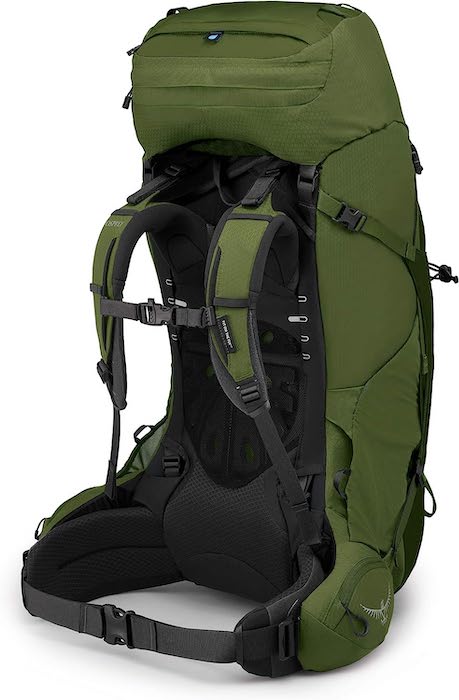
| Weight | Fabric | Capacities | What we like | What we don’t | Great for |
|---|---|---|---|---|---|
| 4 lbs. 15 oz. | Nylon (210D & 420D) | 55, 65L | Super durable and does a great job of staying comfortable with heavy loads | The bag is on the heavier side. And external storage is lacking | Hikers looking to trek longer and need to carry a heavy load while not compromising on comfort |
Osprey’s top backpacking pack is the Atmos AG (featured as our top pick), but when it comes to heavy hauling and light mountaineering, the Osprey Aether 65 takes comfort and features to the next level. Recently updated, the pack replaced the AntiGravity (AG) suspension system with an AirScape back panel. Although less elaborate, it still provides breathable foam and mesh to keep you cool.
The Aether offers excellent adjustability, including a rip-and-stick system that easily customizes the fit of the shoulder straps and hip belt. It also features ample compression straps and attachment points for ice axes, tent poles, and other gear. Notably, and probably one of my favorite accessibility features on this bag is the main compartment is easily accessible through a large J-shaped zipper at the front.
However, the Aether 65 does have some downsides. Its weight is just under 5 pounds, which could be considered heavy for some users. Additionally, the organization is average, with only 5 external pockets (7 counting the water bottle holders). The placement of the hip belt stashes is somewhat inconvenient and hard to reach. For most backpackers, we believe the Atmos offers a more practical all-around design, weighing 6 ounces less. Nevertheless, the Aether excels as a premium hauler, providing a durable and sturdy build that is greatly appreciated by those carrying heavy loads.
I use this bag for my longer treks, and anytime I am traveling. It is my go to bag as it can handle the extra weight, and is extremely durable, when it is getting tossed around at the airport. I love this bag for its ability withstand me packing it full of clothes and necessities for overseas travel!
Check out our full blog on the top rated trekking backpack: Osprey Aether 65 Review.
3. Gregory Baltoro 75 ($290)


| Weight | Fabric | Capacities | What we like | What we don’t | Great for |
|---|---|---|---|---|---|
| 4 lbs. 15.7 oz. | Nylon (210D & 420D) | 65, 75L | Perfect for carrying heavy loads while trekking. Maintains its comfort even when packed full | Not good for minimalists or light trekkers. Can be on the heavy side. | Hikers that need a sturdy and durable pack for heavy loads |
Over the years, Gregory Baltoro 75 has built a reputation for producing exceptionally comfortable backpacks, and their flagship models, the men’s Baltoro and women’s Deva, continue this tradition. These packs are specifically designed to handle heavy loads, featuring robust suspensions, firm yet supportive padding, and excellent organization.
The most recent version of these packs boasts a fully mesh back panel, making it the most well-ventilated iteration of their packs to date. The hip-hugging suspension and pivoting shoulder straps ensure stability while hiking on uneven terrain. The thoughtfully laid-out storage options are one of my favorite aspects of this bag. What is particularly noteworthy are the nine exterior pockets, the U-shaped front access to the main compartment, and generously sized hip belt pockets that easily accommodate anything you may need to carry.
In addition to the aforementioned changes, the latest version offers a high level of customization for the hipbelt and shoulder straps, allowing users to achieve a perfect fit. Moreover, Gregory has incorporated more recycled materials into the pack’s construction, aligning with sustainability efforts. However, it’s worth noting that the Baltoro’s main drawback remains its weight.
The 75-liter model weighs approximately 5 pounds, which is about twice as heavy as the 70-liter Hyperlite Southwest mentioned above. In essence, if you prioritize a lightweight and minimalist approach for your backpacking trip, this pack may not be the best for you. However, if you anticipate carrying 40 pounds or more, the Baltoro will handle the load exceptionally well, and you likely won’t notice the additional pound or two.
Check out our full blog on our top rated trekking backpack: Gregory Baltoro 75
4. Osprey Exos 58 ($260)
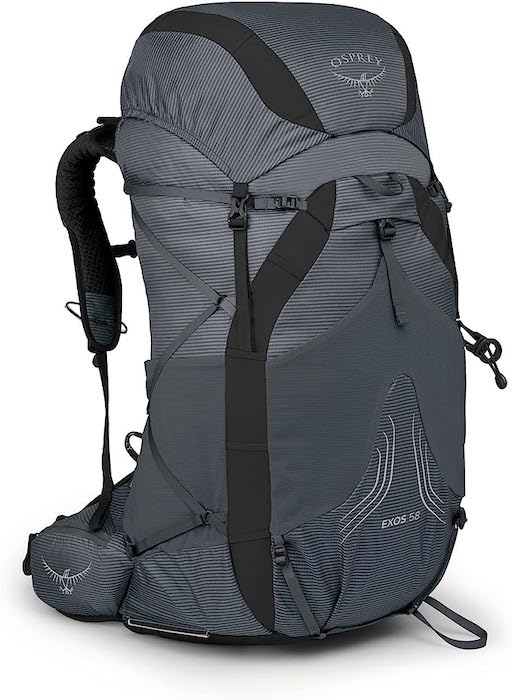
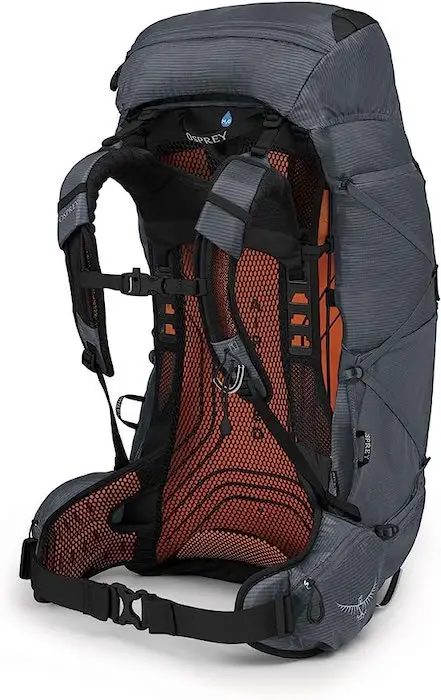
| Weight | Fabric | Capacities | What we like | What we don’t | Great for |
|---|---|---|---|---|---|
| 2 lbs. 13.4 oz. | Nylon (100D & 400D) | 38, 48, 58L | Perfect mixture of comfort, ventilation and quality of backpack build. All while staying lightweight | Not good for minimalists, can be bulky and too much bag for through-hikers | Backpacker looking for a Balance between Comfort and Lightweight |
Osprey Exo 58 has established itself as a prominent player in the backpack industry, renowned for producing high-quality trekking packs with exceptional organization and comfort. This reputation is exemplified by their industry-leading designs like the Atmos/Aura mentioned earlier.
Weighing 2 pounds 13.4 ounces for the 58-liter version, it may not compete with the streamlined options such as the Hyperlite Southwest and Gossamer Gear Mariposa (both weighing under 2 lbs.) However, the Exos offers added weight for enhanced organizational features, carrying comfort, and ventilation. In a spring 2022 update, the latest Exos model incorporates a convenient torso-length adjustment and reintroduces hipbelt pockets, which had been removed in the previous version.
For those accustomed to traditional hiking and trekking backpacks but intrigued by venturing into the realm of ultralight gear, we believe the Exos is an excellent starting pack. While it is not a true ultralight design, thanks to its robust suspension system and decent feature set, the Exos is noticeably lighter and more streamlined than packs like the aforementioned Atmos.
There is a trade-off in terms of durability compared to sturdier traditional packs or pricier ultralight designs that utilize Dyneema or robust Robic nylon. However, we have been pleasantly surprised by the resilience of the Exos’ 100-denier body and base. Overall, the Exos strikes a favorable balance for those seeking both comfort and weight savings, making it a highly appealing choice.
Check out our full blog on our top rated trekking backpack: Osprey Exos 58
5. Granite Gear Blaze 60 ($270)

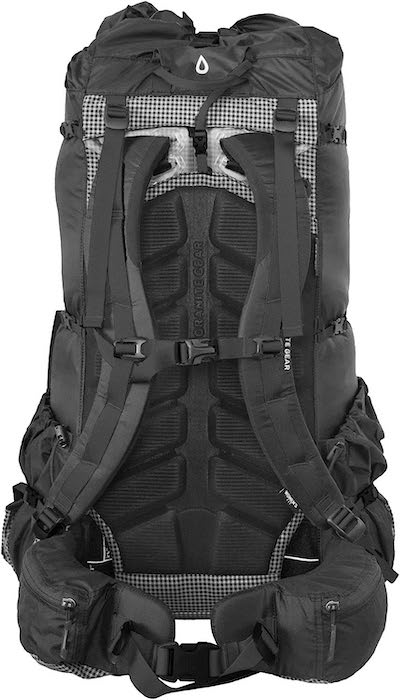
| Weight | Fabric | Capacity | What we like | What we don’t | Great for |
|---|---|---|---|---|---|
| 3 lbs. | Robic nylon (100D & 210D) | 60L | The mixture of comfort, organization, and weight. | The back panel has great padding, but it can get pretty hot, as it has sub-par ventilation | Trekkers looking for a pack that can do a little of everything. |
We love the Granite Gear’s flagship model, the Granite Gear Blaze 60, combines impressive hauling capabilities and efficient organization while weighing a mere 3 pounds. The pack’s robust frame sheet and ample padding on the hip belt and shoulder straps proved exceptionally proficient in carrying a full load (with a rating of 50 pounds).
Additionally, the zippered opening to the main compartment allowed effortless access to gear. Notably, the oversized front and side exterior pockets offered remarkable functionality (one side pocket can accommodate two standard water bottles). What truly sets the Blaze apart is its ability to outperform much of the competition by shedding at least a pound.
While the Blaze 60 boasts numerous merits, there are a few aspects that might not suit everyone’s preferences. The padded back panel prioritizes comfort and support over breathability, making it stiffer and warmer to some of the other trekking bags on this list. Furthermore, adjusting the shoulder straps and hip belt requires some practice and patience. In particular, removing and reinserting the shoulder strap clips behind the frame sheet can be difficult.
Nevertheless, these minor drawbacks are outweighed by the Blaze’s well-rounded construction, earning it a spot as one of our favorite packs in the market.
Check out our full blog on our top rated trekking backpack: Granite Gear Blaze 60.
Trekking Backpack Buying Advice:
Before you choose the right trekking bag, make sure to keep these points in mind while shopping for a trekking backpack for your next adventure.
Importance of choosing the right trekking backpack:
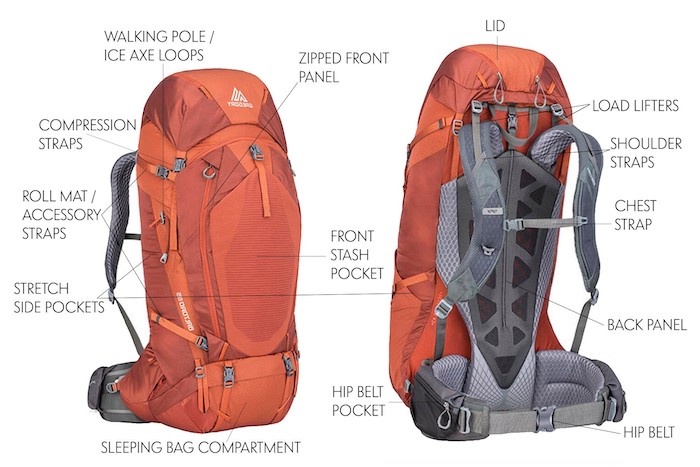
When it comes to trekking, choosing the right backpack goes beyond its aesthetic appeal. It is your lifeline, carrying all your essentials and gear, and must withstand the demands of the rugged outdoors. A well-designed backpack not only ensures that you can comfortably carry your load but also helps distribute the weight evenly, preventing strain and fatigue on your shoulders, back, and hips.
Investing in a high-quality trekking backpack is essential for a successful and enjoyable adventure. Let’s take a look at how to choose the best trekking backpack now.
Factors to consider when choosing a trekking backpack
Before diving into the intricate details of different types of trekking backpacks, it’s crucial to understand the key factors that should guide your decision-making process.
1. Finding the right size and capacity
First thing to consider when choosing a trekking backpack is to determine the right size and capacity. The size of your hiking backpack will depend on the duration of your trek and the amount of gear you plan to carry.
It’s important to strike a balance between having enough space to accommodate your essentials and not going overboard with an excessively large backpack. The capacity is usually measured in liters and can range from 30L for day hikes to 70L or more for longer expeditions.
2. Features to look for in a trekking backpack
A well-designed trekking backpack should offer a range of features that enhance its functionality and convenience. Look for backpacks that have adjustable straps, allowing you to customize the fit according to your body shape and size.
Padded shoulder straps and hip belts help distribute the weight evenly, reducing strain on your back and shoulders. Additionally, consider backpacks with a ventilation system that allows air to circulate between your back and the backpack, preventing excessive sweating and discomfort.
3. Material and durability considerations
Durability is of utmost importance when it comes to trekking backpacks. You need a backpack that can withstand the harsh conditions of the outdoors while hiking, including rough terrains, rain, and abrasion.
Opt for backpacks made from high-quality materials such as nylon or polyester, which are known for their strength and water-resistant properties. Reinforced stitching and robust zippers are also essential to ensure that your backpack can withstand the test of time.
Different types of trekking backpacks:
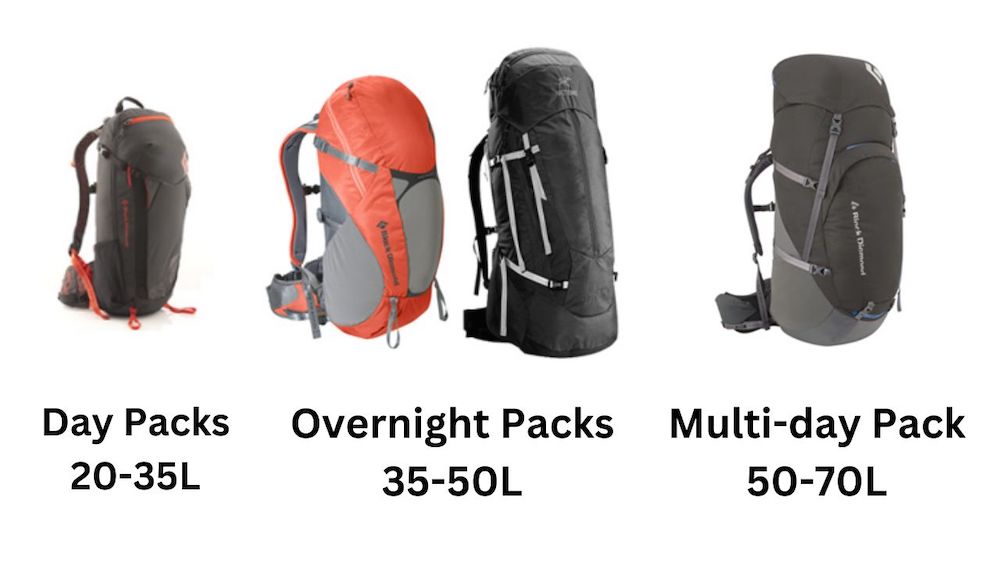
Trekking backpacks come in various types, each designed to cater to specific trekking styles and preferences. Understanding the different types will help you choose a backpack that aligns with your adventure goals.
1. Daypacks
Daypacks are small, lightweight backpacks designed for shorter treks or day hikes. They typically have a capacity of 20-35 liters and are ideal for carrying essentials such as water, snacks, and extra layers of clothing. Daypacks are compact and often feature hydration bladder compatibility, allowing you to stay hydrated on the go.
2. Overnight backpacks
Overnight backpacks, also known as weekend backpacks, are slightly larger than daypacks and are designed to accommodate gear for overnight trips or weekend adventures. They typically have a capacity of 35-50 liters and offer enough space for essentials like a sleeping bag, clothing, and cooking equipment. Overnight backpacks strike a balance between size and weight, making them versatile for a range of trekking experiences.
3. Multi-day backpacks
Multi-day backpacks are designed for longer expeditions, lasting several days. These backpacks have a high capacity, usually ranging from 50-70 liters or more, allowing you to carry all the gear, food, and clothing necessary for extended trips. Multi-day trekking packs often have additional features such as external attachment points, compression straps, and compartments to keep your belongings organized.
Finding the right size and capacity
When it comes to trekking backpacks, one size does not fit all. The size and capacity of your backpack will depend on the duration and nature of your trek, as well as the amount of gear you plan to carry. Below is a quick rundown of what to consider when choosing a backpack size. However, you can also see our in-depth guide that will help you know what size of backpack for hiking and trekking you will need.
1. Duration of your trek
The duration of your trek is a crucial factor in determining the size and capacity of your backpack. For day hikes or short overnight trips, a smaller backpack with a capacity of 20-35 liters will usually suffice. This size allows you to carry essentials such as water, snacks, extra layers of clothing, and a first aid kit.
However, if you’re embarking on a multi-day trek, opt for a larger backpack with a capacity of 35-50 liters or more, depending on the length of your expedition.
2. Amount of gear
Consider the amount of gear you plan to carry on your trek. This includes items such as a sleeping bag, cooking equipment, food, and extra clothing. If you’re traveling light and only carrying the bare essentials, a smaller backpack will be suitable.
However, if you need to carry more gear, opt for a larger backpack with additional compartments and external attachment points to accommodate your requirements.
3. Personal preference
Personal preference also plays a role in determining the size and capacity of your backpack.
Some individuals prefer to travel light and minimize the weight they carry, while others may prioritize comfort and prefer a larger backpack to distribute the weight evenly. Consider your own comfort level and trekking style when choosing the size and capacity of your backpack.
Features to look for in a trekking backpack
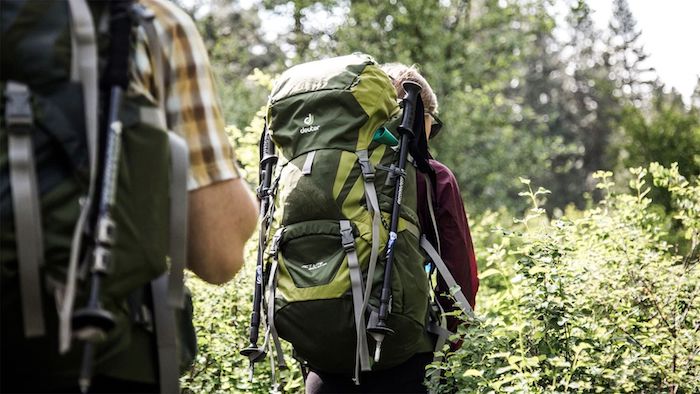
A well-designed trekking backpack should offer a range of features that enhance its functionality and convenience. These features contribute to the overall comfort, organization, and accessibility of your backpack, ensuring that it becomes your trusted companion on your adventures.
1. Adjustable straps
One of the most important features to look for in a trekking backpack is adjustable straps. These include shoulder straps, hip belts, and sternum straps. Adjustable straps allow you to customize the fit according to your body shape and size, ensuring a comfortable and secure carry. Padded shoulder straps and hip belts are essential for distributing the weight evenly, reducing strain on your back and shoulders.
2. Ventilation system
Trekking can be physically demanding, and it’s natural to build up sweat during your adventures. Look for backpacks that have a ventilation system, allowing air to circulate between your back and the backpack. This prevents excessive sweating and discomfort, keeping you cool and dry throughout your trek.
Ventilated backpacks often feature mesh panels or channels that promote airflow and moisture-wicking properties.
3. Compartments and pockets
Organization is key when it comes to backpacks for trekking. Look for packs with multiple compartments and pockets that allow you to keep your gear and belongings organized and easily accessible.
Top-loading backpacks with a main compartment and additional zippered pockets are popular choices. Additionally, bags with external attachment points, such as bungee cords or gear loops, provide extra storage options for items like trekking poles, sleeping pads, or wet clothing.
Material and durability considerations
Durability is a critical factor when choosing the best trekking backpack. Your backpack will be subjected to the rigors of the outdoors, including rough terrains, rain, and potential abrasions. Investing in a backpack made from high-quality materials ensures that it can withstand the demands of your adventures and last for years to come.
1. Bag Material
When it comes to material, nylon and polyester are popular choices for trekking backpacks. Both materials offer excellent durability, strength, and water-resistant properties. Nylon is known for its abrasion resistance and tear strength, making it a preferred choice for rugged terrains.
Polyester, on the other hand, offers superior UV resistance and is less prone to stretching or sagging. Consider the specific advantages of each material and choose one that aligns with your needs and where you plan on trekking the most.
2. Reinforced stitching and zippers
Pay attention to the quality of stitching and zippers when evaluating the durability of a trekking pack. Reinforced stitching ensures that the seams can withstand the stress of carrying heavy loads without unraveling.
Look for backpacks with double or triple stitching in high-stress areas such as the shoulder straps and hip belt. Similarly, robust and reliable zippers are essential for easy access to your gear and to prevent any mishaps during your trek.
3. Water resistance
While no backpack is completely waterproof, having some level of water resistance is crucial for protecting your gear from rain or accidental spills. Look for backpacks with a durable water repellent (DWR) coating, which helps shed water and keeps your belongings dry.
Some backpacks also come with a rain cover that can be pulled over the bag during heavy downpours. Pay attention to the water resistance capabilities of the backpack and choose one that suits the weather conditions you’re likely to encounter.
Comfort and fit of the trekking bag
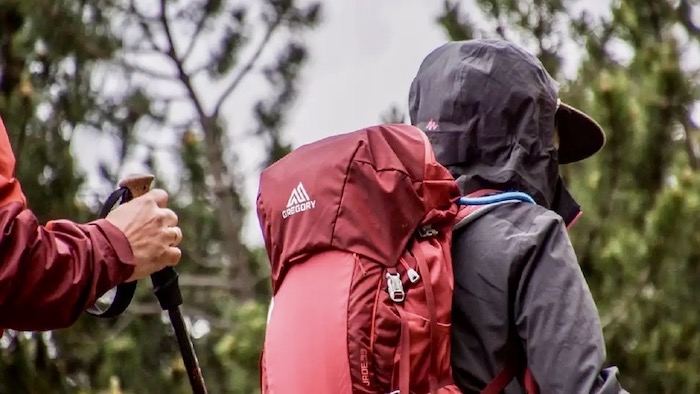
Comfort is paramount when it comes to trekking backpacks. A well-fitting backpack can make a significant difference in your overall trekking experience, preventing discomfort, fatigue, and potential injuries.
Consider the following factors to ensure a comfortable and secure fit.
1. Size and adjustability
Choose a backpack that is proportional to your body size and shape. Most backpacks come in different sizes, and it’s important to select one that suits your torso length. Some manufacturers provide sizing guides to help you determine the correct size based on your measurements.
Additionally, look for backpacks with adjustable straps, including shoulder straps, hip belts, and sternum straps. Adjusting these straps allows you to customize the fit according to your body, ensuring a comfortable and secure carry.
2. Load distribution
A well-designed backpack should distribute the weight evenly across your shoulders, back, and hips. Find backpacks with a padded hip belt that transfers a significant portion of the weight to your hips, reducing strain on your shoulders and back.
The hip belt should sit comfortably, and the weight of the backpack should be supported by your hips rather than your shoulders. Additionally, adjustable sternum straps help stabilize the backpack and prevent it from shifting during your trek.
3. Suspension system
The suspension system of a backpack plays a crucial role in ensuring comfort and load stability. Look for backpacks with a well-padded and ventilated back panel that conforms to your body shape. This helps distribute the weight evenly and prevents pressure points.
Organization and accessibility options
Efficient organization and easy access to your gear can make a significant difference in your trekking experience. Here are three things to consider when finding the best backpack option in terms of organization and accessibility.
1. Compartments and pockets
Multiple compartments and pockets are essential for keeping your gear organized. Look for backpacks with a main compartment for larger items such as a sleeping bag or clothing. Additionally, consider backpacks with zippered pockets or mesh pockets for smaller items like a headlamp, maps, or snacks.
2. External attachment points
Backpacks with external attachment points provide additional storage options for items that you may need quick access to. Look for backpacks with bungee cords, gear loops, or daisy chains that allow you to attach trekking poles, ice axes, or wet clothing.
These external attachment points free up space inside the backpack and provide easy access to essential gear without the need to unpack the entire bag.
3. Accessibility options
Consider the accessibility options of a backpack to ensure that you can easily reach your gear when needed. Some backpacks feature a front-loading design, allowing you to access the main compartment through a zippered panel at the front of the backpack. This eliminates the need to dig through the top or bottom of the backpack to find specific items.
Additionally, backpacks with side pockets or stretchy mesh pockets provide convenient storage for water bottles or items that you may need quick access to.
Best Trekking Backpack: Buying Guide for the perfect bag
Choosing the best trekking backpack is crucial for a successful adventure. It provides comfort, convenience, and safety throughout your journey. A well-designed backpack with proper fit, durability, and storage capacity ensures easy mobility, weight distribution, and quick access to essential items, enhancing your overall experience and enjoyment while trekking.
This buyer’s guide serves as a starting point for your backpack needs. Make sure to ensure that the trekking bag you choose is not solely based on price. Whereas, to spend a little more to have the perfect bag that can carry everything you need, while reducing the risk of injury is the most important thing!
Trekking and hiking can be a fun and exciting time, but not having the best hiking backpack for your trip can ruin everything. So take your time when buying a bag, so you can enjoy the outdoors for years to come!
FAQs: Best Trekking Backpack
Below are some of the most frequently asked questions about the best trekking backpacks.
The best bags for trekking are:
1. Osprey Atmos AG 65
2. Hyperlite 3400 Southwest
3. Gregory Baltoro 75
4. Osprey Exos 58
5. REI Co-op Trailmade 60
For day treks the best backpack is between 20-35 liters. For overnight treks, 25-50 liter bags are typically sufficient. Finally, for multi-day treks, you should carry a bag that ranges from 50-70 liters.
The main difference between hiking and trekking bags is that hiking backpacks are smaller. The popular sizes for hiking backpacks typically range from 15 to 30 liters. The reason behind this is simple: since hiking trips usually don’t involve overnight stays outdoors, there is no need to carry certain equipment or gear that would require larger backpacks.
Check out our hiking vs trekking: what’s the difference, to learn more about what kind of gear and backpack you will need!
A 40L backpack is enough for trekking. Bags with a capacity of 40 to 60 L are sufficient for overnight hikes and multi-day treks. A 50-liter rucksack, in particular, provides ample space to pack all necessary items, including a sleeping bag, for treks lasting up to two weeks.
